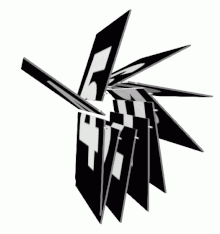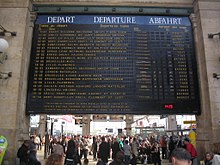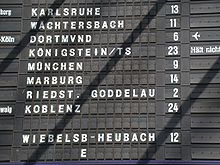Split-flap display
This article may require copy editing for grammar, style, cohesion, tone, or spelling. (January 2025) |





A split-flap display, or sometimes simply a flap display, is a digital electromechanical display device that presents changeable alphanumeric text, and occasionally fixed graphics. They were[when?] commonly used as public transport timetables in airports and railway stations.
They were often called Solari boards after the Italian display manufacturer Solari di Udine, or, in Central European countries, Pragotron after the Czech manufacturer.
Split-flap displays were once commonly used in consumer digital clocks known as flip clocks.
Description
[edit]Each character position or graphic position has a collection of flaps on which the characters or graphics are painted or silkscreened. These flaps are precisely rotated to show the desired character or graphic. These displays are often found in railway stations and airports, where they serve as flight information display system and typically display departure or arrival information.
Sometimes the flaps are large and display whole words, and in other installations there are several smaller flaps, each displaying a single character.
Flip-dot displays and LED display boards may be used instead of split-flap displays in most applications. Their output can be changed by reprogramming instead of replacement of physical parts but they suffer from lower readability. They also can refresh more quickly, as a split-flap display often must cycle through many states.
Advantages to these displays include:
- high visibility and wide viewing angle in most lighting conditions
- little or no power consumption while the display remains static
- Distinct metallic flapping sound draws attention when the information is updated.
The Massachusetts Bay Transportation Authority has designed the new LED replacements for its aging Solari boards at North Station and South Station to emit an electronically generated flapping noise to cue passengers to train boarding updates.[1]
Many game shows of the 1970s used this type of display for the contestant podium scoreboards. Usually, the flip was left-to-right on a vertical axis, although up/down on a horizontal axis was not completely unknown. Early seasons of the game show Family Feud used a split flap display as part of the game board (subsequent seasons used more modern digital displays, and eventually simply used a large digital flat screen monitor). The game board on the Nickelodeon game show Make the Grade was a 7x7 split-flap display, used to display subjects and wild cards, as well as tracking contestants' progress. The television game show Chain Reaction on Game Show Network features computer-simulated split-flap displays to display the various words in a chain.[citation needed]
In Italy, split-flap displays have also been occasionally used as destination signs for transit vehicles; there was also a brief vogue for them in the United Kingdom in the mid 1980s.[2]
Non-informational uses
[edit]The aesthetic appeal of the displays is such that they have also seen use in purely artistic forms, such as in Pedestrian Drama, contemporary artwork using this display technology, and art by Juan Fontanive, who has used the mechanism extensively since 2005.
The album cover for The Enemy's album We'll Live and Die in These Towns is based on the Solari design seen at British railway stations.
Gallery
[edit]-
Flap display at Breukelen railway station, Holland
-
Flap display as departure board at Hannover Hauptbahnhof, Germany
-
Split-flap display with the name of the end station on the tram Tatra KT8D5 in Prague, Czech Republic
-
Cifra 5 clock (1954)
-
Cifra 5 internal mechanism
-
Solari Cifra 23 clock
References
[edit]- ^ Mac Daniel (2006-04-06). "Nostalgia for noise at South Station". The Boston Globe. Retrieved 2022-05-31.
- ^ "Eastern National Olympian Coach". 7 September 1986.





